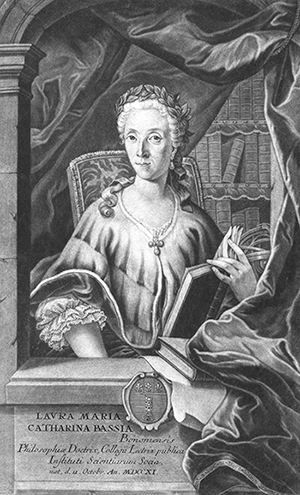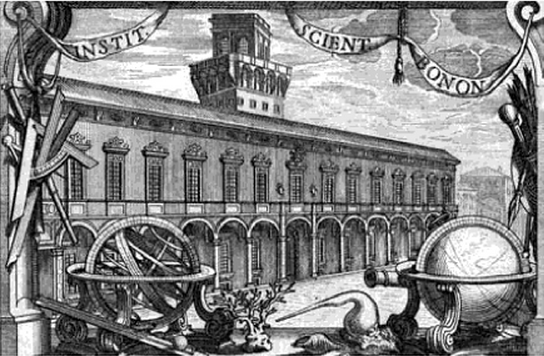In this Happened today I want to talk about an extraordinary woman, scientist, pioneer, that shook the Italian society of the 18th century. Our today’s heroine is Laura Bassi, the first woman to become a physics professor at a European university.

Before I start telling you her story of resilience, I have a disclaimer to make: Nothing glorious happened on July 20th (that we know of) but I am sure that on that July 20th 1732, after receiving her Ph.D., Laura was in some way contributing to the progress of science. After all, as we all know, progress does not happen overnight!
Laura Bassi was one of the shining stars of 18th-century Italian physics – and could well have been the first woman to have forged a professional scientific career. Alberto Elena [1] writes about her:
“She was a figure of the greatest importance in the intellectually flourishing Bologna of the eighteenth century and one of the leading characters in the acclimatisation of Newtonian natural philosophy in the Italian states. While there can be no doubt that the city itself accentuated Bassi’s fame in order to promote its own glory, the little we know about her physical researches and her Newtonian commitment is enough to make it clear that she deserves a place in the history of science.”
Chapter 1: The first years
Laura Maria Caterina Bassi was born in 1711 in Bologna. As it happened for many other geniuses, Laura Bassi showed her talent very early. Her cousin, Father Lorenzo Stegani, started teaching her Latin, French, and mathematics when she was only five years old. It is not surprising that an educated girl at this time would be taught French and arithmetic, but it is very surprising that she was taught Latin. This language, essential for men entering a scientific career, would have been considered useless for even a very well educated girl. Stegani recognized the intellectual talent of Laura early on; this is what he wrote in the preface to the collection of poems published in honour of Laura Bassi in 1732: “To the most learned and erudite young lady Laura M C Bassi.”
When she was only 8 years old, she started showing interest in the new ideas of the Age of Enlightenment promoting the power of reason and a mathematical and scientific approach to the world. She was quickly surpassing her tutor. The family physician and professor of medicine at the University of Bologna, Dr. Tacconi, soon realised Bassi’s remarkable intellectual abilities and asked permission from her family to teach her science. Dr. Tacconi introduced her to advanced topics like logic, calculus, and physics, including Isaac Newton’s Optics which she could read in Latin. Tacconi was very impressed with the abilities of his pupil and through him she began to gain a reputation among the circle of scholars in Bologna.
Several of the members of the Academy of Science of Bologna (equivalent to other recent scientific societies such as the Royal Society) were invited to Bassi’s home by Tacconi, himself a member of the Academy. All were impressed by Laura’s debating skills and also by the ease with which she assimilated knowledge. One of these learned men was Bologna’s archbishop Prospero Lambertini, who believed in acknowledging talent wherever it might be found.
Chapter 2: The doctorate in philosophy
Word quickly spread of Bassi’s intelligence, and in 1732 she was at the center of a series of public events organized by Lambertini. She was only a teenager, but she was becoming famous across Europe.
On March 20th, Bassi was admitted to the Bologna Academy of Sciences as an honorary member, when sixteen (males) members of the Academy unanimously agreed that she be admitted. She was its first ever female member. Lambertini became Bassi’s patron and, to show off his protégé, set up a debate between her and four professors from Bologna on April 17th 1732. The debate was held in the grand Palazzo Pubblico (Town Hall) in Bologna and Bassi defended forty-nine philosophical theses. Monique Frize writes about it [2]:
“The uniqueness of this event is explained by the fact that the candidate was not a young man, as we would expect, but a young woman, 20 year old Laura Bassi. […] Because of her sex, Laura had to perform in a very public manner in order to obtain recognition of her abilities and knowledge.”
Her success led to the award of a doctorate in philosophy in May 1732. She was not the first woman to obtain such a degree (Before her, Elena Cornaro Piscopia received a degree in philosophy from the University of Padua in 1678), but Laura was the youngest of all. She was only 19 years old and she could defend a work worth of the most influential scientists worldwide.
Chapter 3: A chair in physics
Around this time Laura was no longer having Tacconi as a tutor. She had started studying higher mathematics and Newton’s physics with Gabriele Manfredi, one of the Italian pioneers of infinitesimal calculus.
Her unwavering commitment to science and to the recent works of the Scientific Revolution was constantly increasing her fame. Laura was widely known throughout Europe, and as far away as America, as the woman who understood Newton. She was famous to the point that Voltaire wrote to her:
“Most Honoured Lady: I would like to visit Bologna so that I might say to my fellow citizens that I have seen Signora Bassi, but, deprived of this honour, I trust that I may with justice cast at your feet this philosophical homage in reverence to the glory of her century and sex. As there is no Bassi in London I should more happily enter your Academy of Bologna than the English one, even though it may have produced a Newton.”
Following her fame, Laura was appointed as Reader in Philosophy at the University of Bologna. For the first time in history a woman was named to a chair of physics at a university, and she was paid for it!
However, she was still a woman. She had a very small role in the academy and in the university. She was not given much space and she was allowed to lecture only on special occasions when the lecture was open to the public when anyone, including women, could attend. She had not been allowed to lecture to regular classes at the university where the students would all be men. In 1739 she requested that the University of Bologna increase her teaching duties but, despite support from Lambertini, all she was granted was funds for equipment to conduct physics experiments in her home. Despite this, she continued to study and do research, coming in contact with scientists worldwide.
Laura did not give up. They did not want her? She would create her own academy then. Obstinate, stubborn, genius.
Chapter 4: My own experimental physics lab
In 1738 Laura started to organize discussions at home, and soon after she introduced a “domestic academy”, with classes happening twice a week.
On February 7th 1738 Bassi married Giovanni Giuseppe Veratti, a lecturer in science at the University of Bologna. Marta Cavazza [3] writes:
“All the conditions necessary for a relationship between equal partners, in terms of family life and scientific collaboration, were present in the life of the Bassi-Veratti couple. This was not only unusual but almost inconceivable in the social, juridical, and cultural context of the 18th century, much less in the Pontifical State.”
In 1749 Bassi officially opened her “domestic school” at home. Her eight-month course of daily lessons accompanied by experiments brought her renewed and more lasting fame. Bassi offered far more in-depth instruction than either the university, with its traditional curriculum of natural philosophy, or the Bologna Institute, with its weekly demonstrations of experimental physics.
“It is six years since I began giving private physics classes in my house daily, for eight months of the year. I support these myself, paying for all the necessary equipment apart from that which my husband had made when he was lecturing in philosophy. The classes have gathered such momentum that they are now attended by people of considerable education, including foreigners, rather than by youths.”
Laura and her husband had created the first experimental physic lab at home, and the most complete in Italy at that time. Monique Frize writes [2]:
“Several famous men visited the laboratory established by the Bassi-Veratti couple in their home. Some visitors wanted to view experiments done by Laura or Giuseppe; at other times they performed experiments with the couple on interesting problems of the day. Laura debated with men on several of the ideas that were of prime interest in her time, especially those regarding theories of electricity, gases, and water. Giuseppe studied the potential therapeutic effect of electricity on animals and on the human body.”
The laboratory was capable of competing with the university, where there were only two hours of experimental physics a week. The couple Bassi-Veratti had contributed to the development of experimental physics as a discipline.
The culmination of this appreciation would be her appointment as the Bologna Institute Professor of experimental physics in 1776. Veratti took a job as her assistant.
Bassi died on 20 February 1778 at the age of 66.
Of 28 papers by Bassi, which are held in the Bologna Academy of Sciences in Bologna, thirteen are on physics, eleven are on hydraulics, two are on mathematics, one is on mechanics, one is on technology, and one is on chemistry. Many of her papers remain in manuscript form, having never been published.
A university graduate, salaried professor and academician, Bassi may well have been the first woman to have embarked upon a full-fledged scientific career. While teaching physics at home, Laura was also taking care of her 8 children. She broke all the cliches and brought modernity in the 18th century rigid society.

In full spirit of the Age of Enlightenment, we can say that Laura used her intellect without others help. However, it is important to remember the role of the context. There is no isolated genius and there never was. Bologna was a fervid and inspiring city with the oldest university in the Western world (founded in 1088) and with people that for the first time in Italy were supporting a scientific approach to the world.
This helped to inspire her, or better, to enlighten her.
Laura Bassi broke a huge amount of ground for women, for science, and for humanity.
Thank you, Laura.
References:
[1] A Elena, “In lode della filosofessa di Bologna”: An Introduction to Laura Bassi, Isis 82 (3) (1991), 510–518.
[2] M. Frize, Laura Bassi and Science in 18th Century Europe : The Extraordinary Life and Role of Italy’s Pioneering Female Professor.
[3] M Cavazza, Laura Bassi and Giuseppe Veratti: an electric couple during the Enlightenment, Contributions to Science 5 (1) (2009), 115–128.
More readings:
Jule Selbo, Breaking Barriers: A Novel Based on the Life of Laura Bassi, Mentoris 2020.
Luisa Cifarelli, Laura Bassi: emblem and primacy, 2012.


